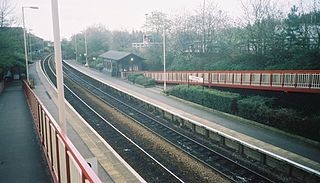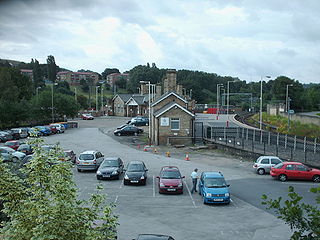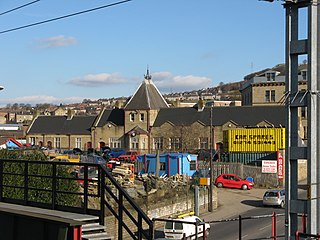
Eccleshill is an area, former village, and ward within the City of Bradford Metropolitan District Council in the county of West Yorkshire, England. The ward population of Eccleshill is 17,540, increasing at the 2011 Census to 17,945. Eccleshill is a more or less completely residential urban area with very little open space although there is substantial open land directly to the east.

New Pudsey railway station serves the towns of Farsley and Pudsey in West Yorkshire, England, on the Calder Valley line. It serves the adjacent suburb of Thornbury.

Shipley railway station serves the market town of Shipley in West Yorkshire, England. It is 2+3⁄4 miles (4.4 km) north of Bradford Forster Square and 10+3⁄4 miles (17.3 km) north-west of Leeds.

Baildon railway station serves the town of Baildon near Shipley in West Yorkshire, England. The station reopened under British Rail on 5 January 1973, by the Chairman of Baildon Council, Arnold Lightowler, having been closed for exactly 20 years. It is situated 4 miles (6 km) north of Bradford Forster Square, on the Wharfedale Line. The station, and all trains serving it, are operated by Northern Trains.

Shipley and Windhill railway station was a railway station in Shipley, West Yorkshire, England between 1875 and 1931.
The Leeds and Bradford Railway Company (L&BR) opened a railway line between the towns on 1 July 1846. It extended its line from Shipley through Keighley to Skipton and Colne, in 1847 and 1848.

Ingrow (West) railway station is a single-platform station serving the suburb of Ingrow in Keighley, West Yorkshire, England. It is served by the preserved Keighley and Worth Valley Railway. The station is 1.25 miles (2 km) west of Keighley station and 2.25 miles (3.62 km) west of Haworth railway station.
The Queensbury lines was the name given to a number of railway lines in West Yorkshire, England, that linked Bradford, Halifax and Keighley via Queensbury. All the lines were either solely owned by the Great Northern Railway (GNR) or jointly by the GNR and the Lancashire and Yorkshire Railway (L&YR). The terrain was extremely challenging for railway construction, and the lines were very expensive to build. The lines were

Queensbury railway station was a station on the Queensbury lines serving the village of Queensbury, West Yorkshire, England. The station was unusual due to its triangular shape, and at its opening the only other examples of this arrangement were Ambergate station in Derbyshire and Earlestown in Lancashire; since then Shipley station, also in West Yorkshire, has gained platforms on all three sides. Of the stations on the Queensbury lines, this was the most ambitious.

Thackley is a small suburb near Bradford, West Yorkshire in England. The village is loosely bordered by the village of Idle to the south, to the west by the West Royd area of Shipley and elsewhere by the Leeds and Liverpool Canal. Thackley is the northernmost part of Bradford south of the River Aire.

Bowling railway station is a closed station in the city of Bradford, West Yorkshire, England. It was on the line connecting the Bradford Exchange - Low Moor line of the Lancashire and Yorkshire Railway with the line of the Great Northern Railway (GNR) at Laisterdyke. It was opened by the GNR on 1 August 1854 and closed to passengers on 1 February 1895. The line remained open to freight until 4 May 1964. No trace remains of the station which was located northeast of the bridge crossing Wakefield Road.

Laisterdyke railway station is a closed station in the city of Bradford, West Yorkshire, England, that served the suburb of the same name.

St Dunstans railway station is a closed station in the city of Bradford, West Yorkshire, England. The station was the location of a three-way junction with platforms on two of the lines.
Thackley railway station was a railway station in Thackley, West Yorkshire, England.
Laisterdyke is an area of Bradford, West Yorkshire, England, situated to the east of the city on the border with City of Leeds and located in the Bradford Moor ward and in the Bradford East parliamentary constituency. Laisterdyke borders Barkerend, Bradford Moor area, Thornbury, Tyersal, and Bowling.
Idle railway station was a railway station in Idle, West Yorkshire, England.

The Shipley Great Northern Railway branch line was a railway line that ran east, south and then westwards from Shipley to Bradford in West Yorkshire, England. The route was opened in 1874 to goods traffic and then to passengers in 1875 by the Great Northern Railway (GNR) and looped around the eastern edge of Bradford. The GNR arrived after other railways had been established in the West Yorkshire area and many of their lines were heavily reliant on tunnels and grand viaducts, the Shipley and Windhill line being an exception to this, although it did have some steep gradients. The branch extended for 8.5 miles (13.7 km) between the two terminuses of Shipley Windhill and Bradford Exchange. The route as built from Laisterdyke to Shipley was actually only 6.5 miles (10.5 km) as the initial section from Bradford Exchange to Laisterdyke was already in existence as part of the Great Northern Railway's line to Leeds.
The Pudsey loop was a railway line in the former West Riding of Yorkshire, England, which served the town of Pudsey and later offered a second connection between Bramley in the east and Laisterdyke and Dudley Hill in the west, in addition to the existing line between Leeds and Bradford Exchange station.

The Leeds, Bradford and Halifax Junction Railway (LB&HJR) was an English railway company. It built a line between Bradford and Leeds, and had running powers over the Lancashire and Yorkshire Railway to Halifax. It opened its main line in 1854 and later built a number of branch lines.
The Great Northern Railway developed an extensive network over time, having started in 1846 with the intention of connecting London and York, as well as other major Yorkshire towns. The Great Northern Railway in Yorkshire was a major part of that, although the GNR did not succeed in reaching York as it originally intended. By acquiring running powers it reached Leeds, Bradford and Halifax over other companies' lines, as well as Barnsley Sheffield and Grimsby, and then York too. After acquiring local companies it developed a network, chiefly in West Yorkshire. Later it built lines north and west of Bradford into hilly terrain, and these were very expensive to build, and never repaid the initial cost.












